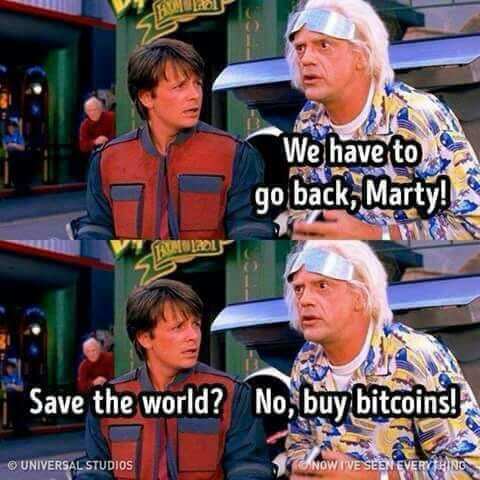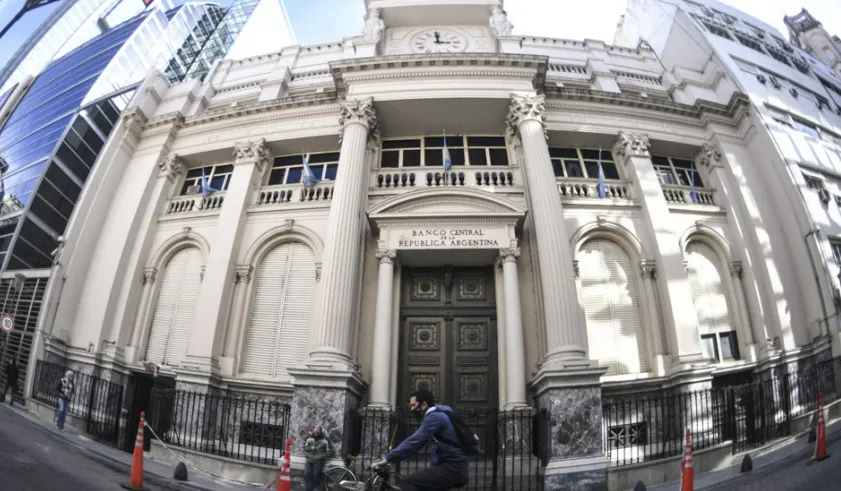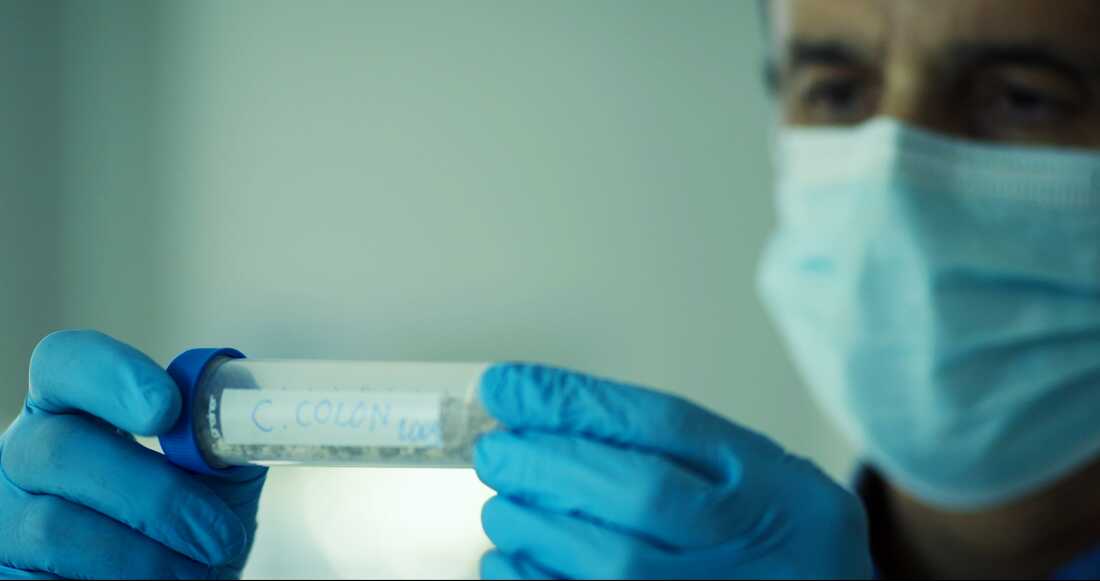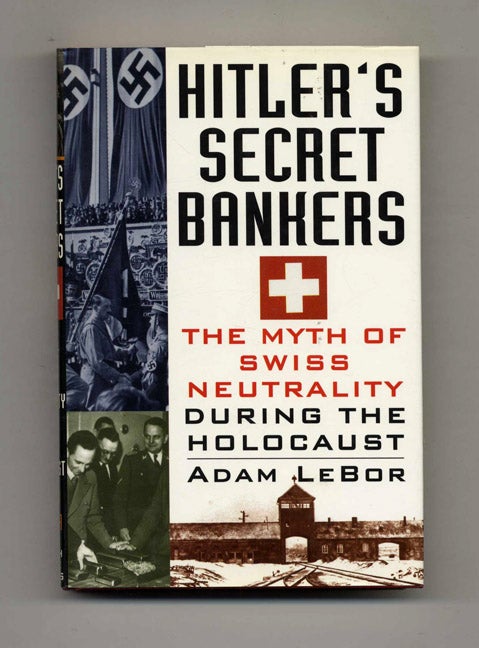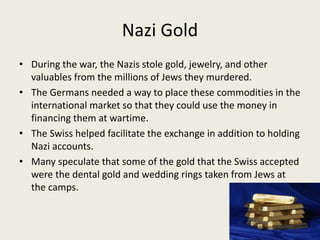|
Reply |
Message 1 of 102 on the subject |
|
Temple de la Madeleine Church - Geneva, Switzerland
Temple de la Madeleine Church - Geneva, Switzerland
Madeleine Church, Geneva, Switzerland. The Temple de la Madeleine Madeleine Church is located in the foot of the Old Town of Geneva, Switzerland
|
|
|
|
Reply |
Message 58 of 102 on the subject |
|
|
|
|
Reply |
Message 59 of 102 on the subject |
|
|
|
La maldición del Estado que con emisión genera inflación
Javier Milei efectuó una Clase pública sobre su Plan de Dolarización, en este segmento nos enfocamos en explicar claramente porque el Estado con emisión genera inflación.
Emisión genera inflación
Javier Milei efectuó una Clase pública sobre su Plan de Dolarización, en este segmento nos enfocamos en explicar claramente porque la emisión genera inflación
A fines de abril, en el Parque O’ Higgins, ubicado en calle Ituzaingó y San Luis, Mendoza y ante más de 12.000 personas (según medios locales) que escucharon atentamente la clase de Teoría Monetaria de Javier Milei, que fue recibido como una celebridad.
Hay un ejemplo que se suele utilizar porque explica muy claramente el concepto. Para aclarar porque lo repite frecuentemente, Milei hace referencia a una de las grandes divas de la historia argentina, la señora Mirtha Legrand, “diríamos que el público se renueva, por lo tanto podría repetirlo porque está avalado porque hay una fórmula exitosa, y nadie está tanto tiempo sosteniendo un éxito si no sirve al prójimo con un bien de calidad a un mejor precio sino que además como decía Ludwig von Mises «Mientras ellos sigan repitiendo sus mentiras, nosotros vamos a seguir contestando les con nuestras mismas verdades». Por lo tanto ahora vamos con el ejemplo:
Supongamos que tenemos una economía que hace transacciones en monedas de oro y de repente viene un amigo físico, con un químico y me dice, mira descubrimos la forma de transformar el plástico en oro, a partir de eso empezamos a comprar plástico y lo empezamos a operar con estas mejoras tecnológicas y lo hacemos que parezca oro. En realidad mientras que ese oro falso solo tuviera en mi casa no constituye ningún delito, es una falsificación, tomé un plástico, le hice cosas, parece oro y nada más.
El problema aparece cuando quiero meter ese oro dentro de la economía porque supongan que ahora yo voy con un lingote y les quiero cambiar a cada uno de ustedes un lingote, mano a mano, lo primero que les parecería es una situación muy rara, ¿porque voy a estar queriendo intercambiar cosas idénticamente iguales? supongamos ahora que les doy dos lingotes por ese lingote, como dice el dicho: cuando la limosna es grande, hasta el santo desconfía.
Está claro que no lo van a poder hacer y de hecho no son tan burdos como para hacerlo de esa manera, por lo que van a convertir los lingotes en monedas y van a empezar a gastar ese oro ese oro falso. All aumentar la oferta de oro el poder adquisitivo del oro va a caer y eso quiere decir que todos los precios suben expresados en unidades de oro. Eso se llama inflación y el único que puede hacerlo es el estado que puede replicar idénticamente la moneda por lo tanto la inflación es siempre y en todo lugar un fenómeno monetario que deriva del crecimiento de la oferta de dinero por encima de la demanda. Por lo tanto, siempre la culpa es del Banco Central, la culpa es de los políticos ladrones.
El mito del rey Midas
Midas fue un rey de Frigia que gobernó en el período entre el 740 a. C. y el 696 a. C. De acuerdo con la mitología griega, el monarca tenía la maldición de convertir en oro todo lo que tocara. Como no podía ni siquiera comer los alimentos, porque a su contacto quedaban transformados en dicho metal, Midas le pidió a Dioniso que lo liberara de su don. Este le dijo que se lavase en el río Pactolo, pero cuando lo hizo, el río se volvió del color del oro. Al igual que el rey Midas, el BCRA pareciera tener una maldición, pero en sentido contrario, porque al emitir dinero genera la maldita inflación, lo que queda claramente explicado en el ejemplo anterior del oro.
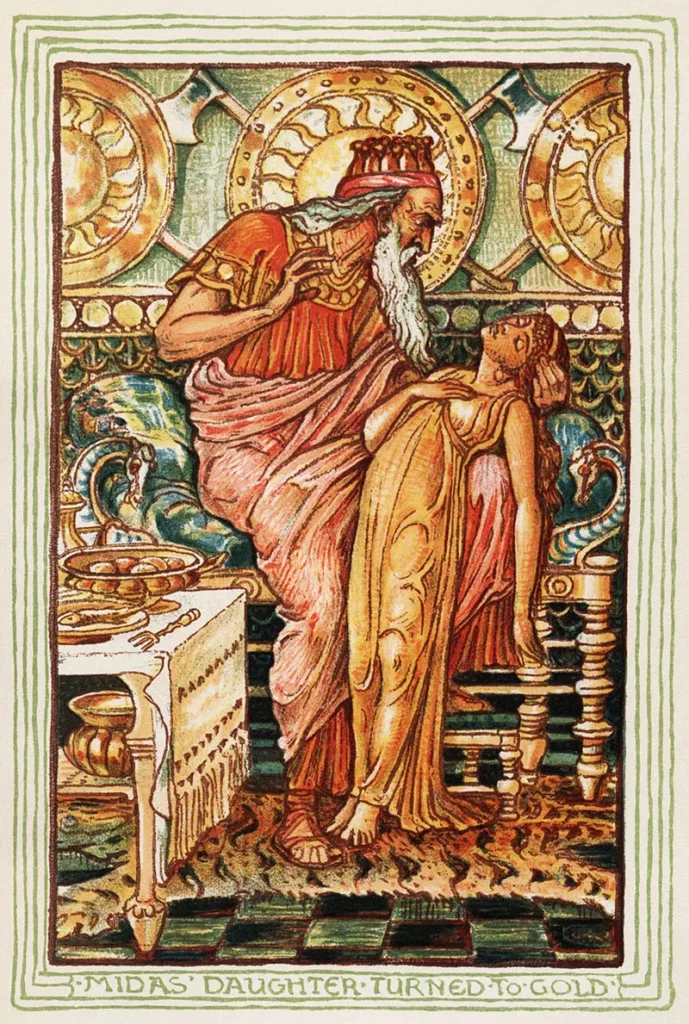 El Rey Midas y la maldición del Estado que genera inflación El Rey Midas y la maldición del Estado que genera inflación
Las tres funciones de la moneda que el Peso no cumple.
Milei sigue su presentación explicando un tema muy importante respecto al Peso que es la moneda argentina, “Lo primero que debería preguntarse respecto al momento en que aparece el dinero es ¿Cuáles son las funciones del dinero? la primera función que debería tener el dinero es ser «Reserva de valor» debería hacer algo que les permita trasladar el consumo del presente al futuro sin que se degrade, porque dejamos atrás lo bienes que mencionamos como el lino, el trigo, la sal, el maíz, el tabaco, todos esos bienes porque se degradaban y si no cumplían la función de reserva de valor”.
“Bueno, el Peso tampoco la cumple, yo creo que vale más una barra de hielo en el desierto del Sahara a pleno mediodía que tener esa basura que emite el político argentino por medio del Banco Central de la República Argentina”. Está claro que la emisión monetaria genera inflación. “En ese sentido, nadie ahorra en pesos, solo aquellos que los obligan a ahorrar en pesos y les dicen que hay que tener pesos. Pero ellos ahorran en dólares!!! Los mismos que les están diciendo y obligándolos a tener pesos son los que ahorran en dólares y cuando le preguntan por eso… ah no, bueno lo mío es otra cosa… Sí claro, la de los argentinos también porque se la ganaron honestamente laburando y no como ustedes manga de parásitos ladrones”.
La segunda función que tiene el dinero es la de ser «Unidad de cuenta» y la realidad es que si ustedes van a comprar lo que se llaman bienes largos o bienes de capital, ya sea un departamento, una máquina, etc la realidad es que los precios están en dólares. Hay una ficción de expresarlos en pesos pero en realidad ustedes saben muy bien que si van a comprar una propiedad van a tener que ir a una sala en el banco para que le pongan los verdes, taca taca, uno arriba del otro, porque nadie quiere arriesgar todo el trabajo de su vida en la moneda de los políticos ladrones argentinos por lo tanto tampoco es unidad de cuenta, solamente sirve para hacer las transacciones del día a día, las transacciones chiquitas en las que nos podemos sacar de encima rápidamente los pesos. Por lo tanto tampoco cumple la función de Unidad de cuenta.
La última función del dinero es la de ser «Medio de pago generalizado» y en realidad el medio de pagos generalizados se da porque hay curso forzoso, una atrocidad que se inventó en el primer Congreso de Génova de 1445 donde los señores feudales, los emperadores, digamos la casta, quería que nadie se desprendiera de la moneda que ellos iban degradando, para aumentar la base imponible del impuesto inflacionario y robar los más con ese impuesto inflacionario, en definitiva han pasado los distintos regímenes y la casta política sigue siendo la misma basura, siguen siendo un conjunto de chorros.
La verdad es que la casta tiene miedo, tiene miedo porque ustedes dejaron de ser corderitos y porque empezaron a despertar de una vez por todas. Son los leones que van a sacar a la argentina de la miseria. Ellos tienen miedo que ustedes sean libres, los quieren esclavos porque así, son ellos los únicos que progresan pero ustedes les van a dar una lección tremendamente fuerte en el 2023 cuando los saquemos en las elecciones presidenciales.
Javier Milei
Demanda y oferta de dinero
Para entender la lógica de la inflación, hay que entender la demanda de dinero y la oferta de dinero. Si ustedes se fijan en esta idea del intercambio indirecto, el dinero está diseñado para hacer transacciones para lo único que sirve es para hacer transacciones, y en ese sentido cuanto más alto es el ingreso mayor es la demanda de dinero. Por otra parte, cuando la tasa de interés sube, como los precios de los bienes presentes se está haciendo más caro que los bienes futuros, ustedes van a pasar consumo del presente al futuro y en lugar de demandar dinero hoy van a demandar más dinero mañana. Por lo tanto, cuando la tasa de interés sube la demanda de dinero cae. Esto para que aprendan los economistas brutos que no conocen y no saben nada de economía intertemporal. Acabamos de hacer la deducción de la demanda de dinero dependiendo del ingreso y de la tasa de interés pero con la lógica intertemporal entendiendo la tasa de interés, no como esa burrada keynesiana que se determina en el mercado de dinero sino como el precio relativo de los bienes presentes sobre los bienes futuros. Los políticos son burros y chantas. En este contexto, supongamos que la oferta de dinero se determina de manera exógena, es una cantidad que la determina el Banco Central de manera arbitraria, pero determina una cantidad fija.
Entonces acabamos de describir la demanda de dinero, pero la demanda de dinero es un término real, por lo tanto para colocar la oferta monetaria en términos reales hay que dividirla por el nivel de precios. Esto se llama ‘saldos reales’ es la cantidad de dinero divido el nivel de precios, es la oferta real de dinero y eso se debe igualar a la demanda de dinero. Vean esto, sí el nivel de precios viene determinado por el cociente entre la oferta y la demanda de dinero, por ende lo único que puede hacer el Banco Central es que cuando determina la cantidad de dinero lo único que está determinando es el nivel de precios y cada vez que insista con modificar las cosas emitiendo dinero lo único que va a hacer es hacer subir los precios y generar inflación.
https://www.mileihoy.com/la-maldicion-del-estado-emision-genera-inflacion/ |
|
|
|
|
|
|
Reply |
Message 60 of 102 on the subject |
|
BCRA: el brazo armado de una corporación política ladrona
Actualizado el 19 de Abril de 2018
En la Primera Conferencia de Génova, celebrada en 1445, los gobiernos establecieron oficialmente el patrón oro y eliminaron la posibilidad de la acuñación privada. Así, el monopolio de la acuñación sentó las bases para que se produjeran "recortes" oficiales en las monedas, al tiempo que se decretaba el curso forzoso de las mismas, lo cual, significaba una sustracción de recursos a los ciudadanos y la desarticulación de los precios relativos. Por otra parte, luego de establecido el monopolio de la acuñación y el curso forzoso, los gobiernos impusieron el monopolio de la convertibilidad. En definitiva, esto último significaba la instauración de organismos estatales con la función de tomar depósitos en metálico y emitir contra ello los recibos correspondientes.
De este modo, los gobiernos descubrieron la posibilidad de emitir estos recibos sin el correspondiente metálico y con ello financiar el gasto público evitando la necesidad de recurrir a impuestos. Sin embargo, cuando esta política trascendía, el público tendía a convertir sus recibos para obtener el metálico, lo cual implicaba una corrida contra las cajas de conversión, por lo cual, para eludir los efectos de dichas corridas los gobiernos suspendían la convertibilidad.
Así, luego de varias crisis monetarias de origen fiscal, finalmente los gobiernos decidieron quitarse la máscara y así decretaron terminar con la convertibilidad. De este modo, manteniéndose el curso forzoso, la clausura de las instituciones de conversión inexorablemente condujo a la aparición de la autoridad monetaria. En este contexto, la autoridad monetaria debía establecer la cantidad de moneda y, de esta manera, influir en el poder adquisitivo de la misma. Por lo tanto, el origen de los bancos centrales no es más que una estafa "legal" contra aquellos que depositaron bienes tangibles a cambio de unos papeles que prometían un repago que luego fue repudiado. Si bien el mecanismo de conversión desapareció, la estafa, bajo el formato de dinero fiduciario persiste y la manifestación de ello es la inflación.
En este sentido, la historia del Banco Central de la República Argentina (un apéndice de la nefasta corporación política) es la prueba palmaria de la existencia de un estafador serial a escala colosal. Previo a la creación del BCRA en 1935, la base monetaria crecía a una tasa anual promedio del 6,1%, mientras que la inflación era del 3,4%. A su vez, en los primeros 10 años de operación, cuando era mixto, la cantidad de dinero pasó a crecer a un ritmo promedio del 13,6% anual, mientras que la inflación trepó al 6%.
Sin embargo, lo peor estaba por venir. Luego de la estatización del "órgano de descontrol monetario" en el año 1946, se pueden diferenciar tres períodos. El primer período va desde la estatización del BCRA hasta 1991, donde la cantidad de dinero creció a un ritmo promedio del 176% anual, al tiempo que los precios lo hicieron al 225%.
Es más, dentro de los logros monetarios del BCRA en dicho período, se registran momentos de alta y muy alta inflación, dos hiperinflaciones y la destrucción de cinco (en rigor seis) signos monetarios. Por ello, a lo largo de los años, los agentes, para preservar su poder adquisitivo demandaron menos moneda local, y con ello amplificaban los efectos inflacionarios de la emisión monetaria.
Luego de semejante catástrofe, se terminó repudiando al dinero doméstico y en abril de 1991 se implementó el Plan de Convertibilidad, el que, mediante una ley, establecía que el BCRA sólo podría emitir contra dólares a una paridad 1 a 1. Al mono salvaje se le quitaba la navaja y el resultado fue contundente. La tasa de emisión promedio entre 1991 y 2001 se ubicó en el 16% anual, mientras que la inflación fue del 9% anual. Sin embargo, en 2002, bajo promesa de que esta vez sería diferente, el salvaje primate recuperó la navaja y su resultado no sorprendió. De 2002 a 2016 la tasa de emisión promedio trepó al 28% anual y con ello la inflación ascendió al 21%. Dicho desastre no ha sido gratis. La diferencia en la tasa de crecimiento de la economía por pasar de una inflación superior al 20% anual a una menor al 5% es de 1,58% por año. Esto es, los más de 80 años del BCRA nos han privado de tener un PIB 3,5 veces mayor al presente.
Por lo tanto, habiendo visto que la inflación es siempre y en todo lugar un fenómeno monetario y los costos que ha implicado para el país, la pregunta es ¿por qué no podemos parar de una vez y para siempre la máquina de imprimir billetes? Y ahí, como todas las pestes que azotan a éste país desde hace más de 70 años, la respuesta está en John Maynard Keynes, quien señalara: "Un gobierno puede vivir largo tiempo imprimiendo dinero. Por este medio puede obtener el control sobre recursos reales, los que son tan reales como los obtenidos por la tributación. Lo que se recauda emitiendo billetes se toma del público del mismo modo que a través de un impuesto a la cerveza o un impuesto al ingreso. El público paga lo que el gobierno gasta. No existe déficit que no se cubra".
En definitiva, la historia monetaria argentina no es más que la contracara del despilfarro fiscal, por lo cual, ello nos indica que el Banco Central es un mecanismo por el cual la corporación política estafa a los individuos de bien creadores de riqueza y que no es una locura intentar eliminar al BCRA, sino que, además, a la luz de la calidad humana, ética y moral de la corporación política argentina, la verdadera locura es tenerlo.
https://www.cronista.com/columnistas/BCRA-el-brazo-armado-de-una-corporacion-politica-ladrona-20180419-0011.html |
|
|
|
Reply |
Message 61 of 102 on the subject |
|
GENOA, ITALY – COLUMBUS, CINQUE TERRE, AND SEPHARDIM

Monterosso – Cinque Terre, Italy
Up the Italian coast from Pisa is Liguria. This region encompasses the historic Republic of Genoa. Genoa was a major banking centre in the 16th century, and it maintained close economic relations with Spain and at times France until its defeat by Napoleon. It has a complicated Jewish history, as well as particular intrigue as the birthplace of Christopher Columbus. I recently travelled across the region and I thoroughly enjoyed its mix of natural and historic beauty.

Columbus Monument (1846) on Piazza Acquaverde – Genoa, Italy
Liguria is sometimes called the Italian Rivera, and it is home to breathtaking Cinque Terre. Perched along cliffs abutting the Mediterranean, these ‘five lands’ are a delight for the senses. The aroma of lemon trees, the sound of waves crashing against the rocks, and the sparkling colour of the sea and cities create a tantalising experience. Collectively, the towns form a protected national park, and are linked together by foot trails and trains. I absolutely loved walking along them!
Just outside of Cinque Terre is the town of La Spezia, once home to the Italian navy. In the seventeenth century Livornese Jews settled there and even in nearby Lerici (with its ship building industry), where they lived in a ghetto. However, today not much remains of these earlier Jewish settlements. All of these areas were under the rule of the Republic of Genoa. Jewish fate therefore rose and fell with Genoa’s policy towards its own Jewish population.

Redeveloped Genoa Harbour
Following the Expulsion, a group of Spanish Jews settled in Genoa. Soon afterwards, Portuguese conversos followed them to this important maritime port. Then, in the mid-sixteenth century, Genoa expelled its Jews. In the seventeenth century Sephardic merchants were readmitted into a newly established ghetto, though their status remained uncertain. This inconsistent policy kept their numbers relatively small, especially compared to the nearby Sephardic metropolis of Livorno, located in Tuscany to the south. However, following Italian unification, and the decline of Livorno’s economy, many Portuguese Jews relocated to Genoa (just as many others relocated to Florence).

Genoa Synagogue
Genoa’s Jewish community continued to grow and in 1935 they built an impressive synagogue just outside the historic city centre. At that time its Jewish population numbered around 2500 souls. Tragically, just a few years later 250 of its Jews were killed in the Holocaust, and over the ensuing years most others left the area. Today, about 250 Jews remain. The imposing synagogue building contains a large sanctuary which is now only used on Holidays. During the rest of the year the community prays in the building’s smaller sanctuary, with a gorgeous historic Hehal (ark) from Genoa’s earlier synagogue.

Genoa Synagogue’s Large Sanctuary

Genoa Synagogues’s Small Sanctuary
Rabbi Giuseppe Momigliano was kind enough to show me around the synagogue and to share with me about the community. He told me that an elderly hazzan had taught him the Western Sephardic rite when he first arrived thirty year ago! Rabbi Momigliano also showed me his study, with its incredible bookcases full of historic safarim (Jewish books). One Bible, printed in 16th century Venice, even contains seventeenth century black out marks made by Christian censors!

16th Century Venetian Hebrew Bible with Christian Censorship
Of course, no discussion of Jewish Genoa would be complete without reference to its most famous resident, Christopher Columbus. Just outside the city gate is a small stone building, said to have been Columbus’ childhood home (or at least built in the 18th century on the foundation of where his home once stood). There is a lot of speculation surrounding the great explorer, including the question of his family’s origins. Since 1892 some have suggested that he came from Jewish (converso) stock. Historians now snicker at such assertions, though strangely the myth remains. It is probably reinforced by the 1492 convergence of his voyage to the Americas and the Expulsion. While there is no basis for this Jewish fantasy, as Jews we can still appreciate the Talmudic teaching that ‘G-d always provides the ‘cure’ (America) before the ‘illness’ (Expulsion).’

Christopher Columbus House – Genoa
Those wishing to visit the beautiful and fascinating region of Liguria should consider spending Shabbat in Genoa. Genoa’s impressive historic centre, with intact districts from medieval, early modern, and modern times, makes it a worthwhile destination.
Rabbi Momigliano told me that he would love to welcome Jewish groups to celebrate Shabbat with the community. Those interested in shabbat meals are welcome to email Rabbi Momigliano at Giuseppe.Momigliano@gmail.com.

Rabbi Giuseppe Momigliano – Genoa, Italy
https://shalommorris.com/2017/05/10/genoa-italy-columbus-cinque-terre-and-sephardim/ |
|
|
|
Reply |
Message 62 of 102 on the subject |
|
Christopher Columbus may have been a Spanish Jew, according to a new documentary
OCTOBER 16, 20245:00 AM ET
Christopher Columbus landing in America with the Piuzon Brothers bearing flags and crosses, 1492.
Hulton Archive/Getty Images/Hulton Archive
SEVILLE, Spain — Conventional history states Christopher Columbus was from Genoa, Italy, but he may have been, in fact, a Sephardic Jew from the eastern Iberian Peninsula, according to a new documentary by Spain’s national broadcaster that also rekindles questions of religious persecution and the treatment of Indigenous communities.
Broadcast by Spanish national public network RTVE on Oct. 12, the day of Spain’s national holiday marking the arrival of Columbus’ expedition to the Americas, Colón ADN, su verdadero origen, or “Columbus’ DNA, his true origin,” follows forensic medical expert José Antonio Lorente as he studies multiple hypotheses regarding the origin of the famed explorer and contrasts the information with scientific and historical evidence.
The documentary concludes that the most plausible theory is one maintained by a Catalan architect who has dedicated many years trying to demonstrate that Cristóbal Colón — Columbus’ name in Spanish — was a Jewish man from the region of Valencia, on the Mediterranean coast of eastern Spain.
Some in the scientific community, however, have expressed skepticism about the methods and scientific rigor that Lorente employs, and highlight the fact that Lorente’s findings have not been presented for peer review yet.
Columbus’ origins come into question
Few things about Christopher Columbus can be stated as facts. Legend has it that at a party with noble Spaniards he demonstrated the possibility of the impossible by making an egg stand on its tip. There is a trick, of course: he flattened the edge of the egg without breaking it.
But there are some details that have not been questioned by most people through the years. Like the fact that Columbus came from Genoa, in Italy. That he persuaded Spain’s Catholic monarchs to sponsor an impossible voyage to the Indies traveling west instead of east from Spain.
Lorente, a forensic medical expert at the University of Granada, has researched Columbus’ origin for the past 22 years. In the documentary, he considers a number of theories about the origin of Columbus, examining them against DNA evidence and historical records.
Finally, Lorente arrives at the garden of Francesc Albardaner, a Catalan architect who authored the book La catalanitat de Colom. According to Albardaner, Columbus was a Sephardic Jew, part of the that Jewish diaspora associated with the Iberian Peninsula. Columbus would have followed Jewish traditions and customs, although in the public sphere he acted as Christian. He was born into a family of silk weavers from the Spanish city of Valencia, where there was a long tradition within the Jewish community of silk weavers.
But in order to determine Columbus’ ancestry, Lorente has to overcome a first hurdle, to shed light on the question of where the true remains of the sailor are.
People visit the tomb of Christopher Columbus at the Cathedral of Seville on October 11.
Cristina Quicler/AFP via Getty Images
Columbus’ disputed resting place
The mausoleum of Christopher Columbus here in Seville features four bronze heralds representing the four Spanish kingdoms before they came under a single rule, in 1469. On the heralds’ shoulders, a massive tomb that the Catholic Church and local authorities assure contains the remains of Columbus.
But Columbus’ resting place has been in dispute for centuries. The Columbus Lighthouse is a huge mausoleum monument to the explorer located in Santo Domingo, capital of the Dominican Republic. The monument was inaugurated in 1992 and, according to Dominican authorities, Columbus’ remains are inside the mausoleum.
There seems to be agreement among historians about the fact that the remains of Columbus, who died in Spain in 1506, were at one point taken back to Hispaniola, the Caribbean island containing the Dominican Republic and Haiti. But that's where historical agreement ends. Some claim the remains of Columbus made their way back to Spain, while others say the wrong bones were taken from Santo Domingo, and therefore Columbus remains in the Dominican Republic.
In Columbus’ DNA, his true origin, Lorente uses DNA from Hernando Colón, son of Christopher Columbus, and distant cousin Diego Colón to verify that the few bones that were housed at the Cathedral of Seville are indeed the true remains of the sailor.
Lorente’s conclusion is unequivocal: Christopher Columbus was of Jewish descent. That led to a process of deduction based on historical evidence. The documentary states that during Columbus’ time there were only an estimated 10,000 to 15,000 Jewish people living on the Italian peninsula. By contrast, there were about 200,000 Jewish people living in what is now Spain, an estimate that may be low, since tens of thousands of Jewish people had converted to Catholicism over the previous century, victims of constant persecution.
Also in the documentary, Albardaner, the Catalan architect, says Genoa had expelled its Jewish population in the 12th century. There were virtually no Jewish people living in Genoa in the times of Columbus, who lived from 1451 to 1506, and Jewish people doing business were only allowed to enter the city for three days at a time.
If the DNA evidence studied by Lorente suggests Columbus was a Jewish man, then it becomes highly improbable that he was from Genoa, according to Albardaner.
Forensic medical expert José Antonio Lorente examines DNA evidence in an image from the documentary Colón ADN, su verdadero origen.
Story Producciones
Why would Columbus lie about his heritage?
On Oct. 19, 1469, a young couple was married in Valladolid, Spain. Queen Isabella and King Ferdinand II, the Catholic monarchs, came to be known for a number of historical achievements, such as unifying the kingdoms that now comprise Spain, or the so-called reconquista (reconquering) of Al-Andalus, the vast region of southern Spain that had been under Muslim control for centuries. But during the Catholic monarchs’ rule the Spanish Inquisition also acquired unprecedented powers. A judicial institution linked to the Roman Catholic Church, the Inquisition sought to identify heretics and order Jews and Muslims to convert to Catholicism, using brutal methods.
But Muslims were not the only people living in the Iberian Peninsula that the Catholic monarchs seemed to want to get rid of. In 1492 the monarchs signed the Alhambra Decree, which ordered the expulsion of Jewish people, seeking to eliminate their influence on Spain's large population of converts, and to make sure its members did not revert to Judaism. The monarchs ordered the remaining Jews to convert or face expulsion from Spain.
Devin Naar, Sephardic studies program chair at the University of Washington, told the BBC's Newshour that escaping persecution in the times of the Catholic monarchs and the Spanish Inquisition was not as easy as simply converting to Catholicism:
“What the Spanish Inquisition did was that it targeted, not Jews as Jews and not Muslims as Muslims, but rather initially and specifically those who were of Jewish or Muslim origin, but who had converted to Catholicism. And there was the perception that they had continued to practice Judaism on one hand or Islam on the other hand in secret. The Inquisition used a variety of different means to try to coerce confessions. It used all of the different medieval tools that we might think about, including burning at the stake,” Naar said.
So Columbus may have been hiding his Sephardic origins to avoid stigmatization, persecution, or even death.
Naar adds that the claim that Columbus was of Spanish-Jewish origin or converso origin — conversos is what the Spanish called Jewish converts to Catholicism and their descendants — has been around for more than 100 years.
Disagreement from the scientific community
The release of the documentary on RTVE has sparked criticisms from the scientific community. Most notably, a recent article published by the Spanish newspaper El País has several experts questioning the process Lorente used to reach his conclusions.
"I don't understand how data that the scientific community has not yet endorsed is presented to society, which puts the data itself and the hypotheses proposed at risk," Antonio Alonso, a geneticist and former director of Spain’s National Institute of Toxicology and Forensic Sciences is quoted as saying.
Rodrigo Barquera, an expert in archaeogenetics at Germany’s Max Planck Institute for Evolutionary Anthropology, told El País he was surprised that Lorente’s findings had been shared without prior scrutiny from others in the scientific community.
Even the DNA angle is questioned by Antonio Salas, who directs the Population Genetics in Biomedicine group at the Health Research Institute of Santiago de Compostela, telling El País: “The documentary promised to focus on DNA analysis. However, the genetic information it offers is very limited.”
Lorente, in response, told El País that the documentary is a film, not a scientific publication, and he promises scientific findings will be presented in the near future.
The evolving role of Columbus in history
Columbus’ actions, once regarded as accomplishments, have become a symbol to many as a starting point for a history of abuse. To others, Columbus, 1492, and what came after, are still worth celebrating.
To this day, Spain marks Oct. 12 as a national holiday, also widely known as Hispanic Heritage Day, to commemorate the arrival of Columbus’ expedition in the Americas. And to this day, Spain’s popular culture has not been able to shake up the use of the controversial term “Descubrimiento de América” (the discovery of America) to refer to that moment in history.
In Latin America and to many U.S.-based Latinos and Native Americans, the so-called “discovery of the Americas” was only the beginning of a cruel history of extermination, subjugation and colonization of its native people and lands. This continues to play a role in international diplomacy. Just last month, the recently elected first woman president of Mexico did not invite the Spanish king to her inauguration as part of an ongoing spat between the two countries over the history of Spanish colonization. Spain’s current government, led by the progressive Socialist Party, said that Mexico’s decision was unacceptable.
Protesters topple a statue of Christopher Columbus during a demonstration against government in Barranquilla, Colombia on June 28, 2021.
Mery Granados Herrera/AFP via Getty Images
The United States has recognized Columbus Day as a federal holiday since 1934, when President Roosevelt designated the standing. For many in the Italian American community, the presumed fact that Columbus was originally from Italy has been a reason for pride and celebration. In 2022, however, President Biden issued a proclamation on Indigenous Peoples Day, and both are observed on the second Monday of October, but most government websites continue to list “Columbus Day” as the federal holiday the nation celebrated this week.
Spain did take measures to remediate the harm done to Sephardic Jews. In 2015 the Spanish Parliament approved an act granting Spanish citizenship to Sephardic Jews with Spanish origins. Spain has not provided reparations to descendants of Spanish Muslims who once lived in the Iberian Peninsula.
https://www.npr.org/2024/10/16/g-s1-28462/christopher-columbus-spanish-jew-documentary |
|
|
|
Reply |
Message 63 of 102 on the subject |
|
|
|
|
Reply |
Message 64 of 102 on the subject |
|
Oak Island – the Templar and Viking connection!

Since the mid-nineteenth century, Oak Island has been claimed as the site for a vast, secretly hidden store of Templar treasure. Possibly the location of priceless items they discovered under the Temple of Solomon in Jerusalem.
Vast amounts of money have been spent excavating below ground to find millions of dollars worth of medieval booty. Companies have been set up with the sole task of getting to the treasure left behind by these enigmatic warrior knights. So – is the wealth of the Templars actually there?
Of course the answer is – we don’t know. But let’s try and figure out how the story has come about and why it still exercises such a tremendous hold on the popular imagination.
The Viking link to Oak Island
I think a good starting point are the claims made in the 20th century that the Vikings had got to the New World long before Christopher Columbus. Why is this important? Because if the Vikings could have got there – then why not the Templars?
This theory has been supported by the so-called Vinland map (dating from the 15th century), that seems to show our Viking ancestors touched down in north America. Trouble is, the map is just a little too good to be true and even though scholars from the British Museum and Yale backed it up in the 1960s, the evidence (for example dating of the ink) suggests it could be a forgery.

If it was true, the Vinland map would establish the feasibility of Europeans sailing across the Atlantic to the American coastline. It’s not beyond the realms of possibility because the Vikings did get to Iceland and Greenland. Some Templar conspiracy theorists suggest the knights or those who helped them had access to Viking navigation charts.
TEMPLAR EXCLUSIVE: Do you want to find your Templar ancestors?
The Templars and Oak Island
Moving away from the Vikings now, let’s shift our focus to the Knights Templar. In 1307, their number was up. Philip, king of France, had ordered the arrest of all the knights and they were interrogated under torture in various dungeons. But if the king had hoped to find lots of loot at the Paris Temple, their headquarters, he was to be severely disappointed. Only empty shelves greeted his soldiers.
We then get the story of Templar treasure being spirited away from Paris in wagons bound for the port of La Rochelle and from there on to Scotland (and/or maybe Portugal, see my other blog posts on that option). And then – the wealth of the Templars simply evaporates into thin air!
In his book Lost Treasure of the Knights Templar: Solving the Oak Island Mystery, Steven Sora claims that the Templars’ treasure – gold, silver, jewels and sacred relics of immense power – were firstly hidden away in the crypt at Rosslyn chapel by the Sinclair family. The Sinclairs are central to the whole Templar getaway-via-Scotland theory.
The Sinclair connection
Quick detour on the Sinclair family then. They are an ancient Scottish family that includes Henry, the first earl, who fought alongside the first Grand Master of the Templars, Hugh de Payens (or Payns) in the Holy Land in the early 12th century. So, we have an early association between this family and the order of knights.
Fast forward to the early 14th century and Sir William Sinclair (sometimes spelt St Clair or Saint-Clair) is sometimes held up to have been the last Templar Grand Master before his death in 1330. Trouble is, he also appears to have given evidence at their trials AGAINST the Templars – somewhat scuppering that theory unless he was involved in some kind of complex double bluff!
Then we have another Henry Sinclair who in the late 14th century allegedly explores the coast of north America with an Italian navigator called Antonio Zeno. This establishes the idea that the Sinclair family know all about the New World so are ready for a subsequent very important voyage.
According to Steven Sora, the Sinclairs leave the Templar treasure under Rosslyn until the 16th century. But then along comes the Protestant Reformation. The Sinclairs are devout Catholics. Fearing that that the Templar treasure might be seized, they set sail with it and land on…Oak Island!
Daniel McGinnis on Oak Island
Now, nothing more gets said about this – obviously, being a secret mission – until the 19th century. Then stories circulate in newspapers of discoveries made on the island by a man called Daniel McGinnis in the 1790s. I’ve read different versions of the McGinnis story. In one account, he found a curious depression in the ground while setting up his farm. Or, he saw unusual lights on the island one evening and sailed across, discovering the pit when he got there.
The story of McGinnis and his excavations only emerges fifty years later in a paper called the Liverpool Transcript. By the mid-nineteenth century, tales of pirates and their hidden treasure had become the stuff of boys’ magazines. In 1881, the author Robert Louis Stevenson would publish Treasure Island in a boys’ magazine called Young Folks. The Oak Island booty came to be associated with both the Templars and notorious pirates like Captain Kidd and Blackbeard.
This was also an era of gold rushes – speculators dashing to reputed finds of the precious metal. So, maybe not entirely surprising that Oak Island was soon swarming with diggers. The main attention was the Oak Island Money Pit. This was a curious shaft with what appeared to be booby traps set at different levels.
Most intriguing was the discovery of a stone slab that allegedly has carved on it the message: Forty feet below, two million pounds lay buried. That line is best said if you impersonate Nicholas Cage in the movie National Treasure. More seriously, at least six people have died investigating the very deep money pit due to flooding and in one case, a boiler exploding.
The Franklin Roosevelt connection

One well known Oak Island devotee was the US president Franklin Roosevelt (pictured above). The Democrat occupant of the White House through the 1930s was a Freemason and from his youth until his death in 1945, retained an abiding interest in the site. One feature that apparently gripped him was the rumour that the jewels of the last queen of France, Marie Antoinette, had been squirrelled away on the island.
Which brings us to the 21st century! Such is the level of interest in Oak Island that the History channel has just commissioned a whopping 30 hours for season six of its series The Curse of Oak Island. This runaway success of a documentary series features two Michigan brothers Rick and Marty Lagina who have bought much of Oak Island to pursue the treasure hunt. They are accompanied by local expert, Dan Blankenship.
Rick is a retired US postal worker who passionately believes something lurks under the surface. His brother Marty is the sceptical foil raising doubts every so often about their enterprise. However, as the digs proceed, Marty is seen to convert by degrees to the cause.
The programme has attracted an impressive four million views. And it’s spawned two spin-offs: The Curse of Civil War Gold and Yamashita’s Gold. The first spin-off speaks for itself. The second is the alleged burial of treasure by Japanese soldiers in the closing days of World War II in the Philippine jungle.
In case you missed my recent outing on the History channel – I appeared in episode four of the Templar documentary series Buried earlier this year. Together with presenters Mikey Kay and Garth Baldwin, we looked for Templar treasure in the ancient citadel of Tomar in Portugal.
|
|
|
|
Reply |
Message 65 of 102 on the subject |
|
Una de las características más significativas de los relojes es su historia, de eso no hay duda, así es la de este Vacheron Constantin. Imaginemos ahora una pieza que Eva Perón escogió dentro de las miles de opciones de alta relojería. Pues la argentina optó, a mitad de los 40, por un Vacheron Constantin Ref. 4195 en oro para obsequiar al aviador militar, Fernando Rein Loring y este 2020 estará en subasta para el mejor postor.
A ella, reconocida por su interminable lucha por la igualdad de los derechos sociales, no le era ajeno ser generosa con personas que lo merecían, era especialmente agradecida con todo esos que aportaban algo a momentos particulares de su vida. En 1947, realizó una gira europea y Fernando Rein Loring fue quien hizo el viaje trasatlántico para llevar a Eva Perón hasta España, para reunirse con el General Francisco Franco, razón suficiente para mostrar su agradecimiento con una pieza de alta relojería. Y así como Ali, Obama y Steve McQueen tenían al Tank de Cartier como su reloj favorito, la historia cuenta que Eva Perón tenía a Vacheron Constantin situado como uno de lo suyos.
Fernando Rein Loring se convirtió en el primer piloto en completar el viaje individual de 16,000 km de Madrid a Malina a 150 km/h. Fue creador de má de 37 mil fotografías aéreas de España y fue enviado por el gobierno español para recoger a Perón en un avión más que equipado: dos cuartos con sillón, mesa, espejo, tocador y cama.. no cabe duda que después de un trato espectacular como éste, por parte del piloto y el copiloto Cecilio Imaz Bastida la llevaran de Buenos Aires a Madrid. Y el mejor recuerdo de esa hazaña, fue esta gran pieza de Vacheron Constantin en oro, y de eso no hay duda hasta el día de hoy.
El adverso y reverso del Vacheron Constantin que Eva Perón regaló al piloto ibérico.Antiquorum
El valor estimado
Este mes de junio, Ginebra será el lugar para subastar el reloj por Antiquorum. La casa suiza tiene una predicción de que la pieza de Vacheron Constantin supere los 15,000 francos suizos (un poco más de 350,000 pesos), porque además de su valor como pieza de alta relojería, su estimación aumenta por el peso histórico que representa.
La fecha de subasta
La cita tan esperada para la subasta de esta pieza con extra valor histórico es el próximo 28 de junio, en la página web del subastador más importante de relojes históricos y clásicos, Antiquorum.
Características del reloj
-
Marca: Vacheron Constantin
-
Año: alrededor de 1946
-
Caja: 36 mm
-
Calibre: V453
-
Movimiento: 461184
-
Correa: oro rosa de 18 quilates
-
Valor agregado: esfera con dedicatoria, “María E.D. de Perón a Fernando Rein Loring”, siglas completas de María Eva Duarte de Perón.
Comprobante de autenticidad
Junto a la pieza de reloj de Vacheron Constantin, viene una medalla de oro conmemorativa de 18 quilates, además de que ambas piezas con valor histórico están acompañadas de una carta de la aviación civil que confirma la entrega de la esposa de Franco a Eva Perón, un reloj clásico en el que vale la pena invertir, un trío lleno completamente de historia y que pasará directo a manos de un buen coleccionista.
Izquierda: Eva Perón en 1946. Derecha: la carta, medalla y reloj que comprueban la autenticidad de las piezas.Bettmann / Antiquorum
https://www.gq.com.mx/relojes/articulo/subastan-vacheron-constantin-que-eva-peron-regalo-a-fernando-rein-loring |
|
|
|
Reply |
Message 66 of 102 on the subject |
|
|
|
|
Reply |
Message 67 of 102 on the subject |
|
|
|
|
Reply |
Message 68 of 102 on the subject |
|
|
|
|
Reply |
Message 69 of 102 on the subject |
|
|
|
|
Reply |
Message 70 of 102 on the subject |
|
|
|
|
Reply |
Message 71 of 102 on the subject |
|
|
|
|
Reply |
Message 72 of 102 on the subject |
|
|
|
 First First
 Previous
58 a 72 de 102
Next Previous
58 a 72 de 102
Next Last
Last
|
 El Rey Midas y la maldición del Estado que genera inflación
El Rey Midas y la maldición del Estado que genera inflación


